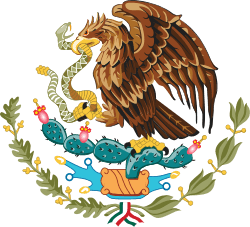Plan of Guadalupe
| |
A graphical timeline is available at Timeline of the Mexican Revolution |
The Plan of Guadalupe (Spanish: Plan de Guadalupe) was a document drafted on March 23, 1913 by Venustiano Carranza in response to the overthrow and execution of Francisco I. Madero, then President of Mexico. It was formally proclaimed three days later on March 26 in Carranza's hacienda.
Madero's overthrow was the work of Victoriano Huerta, who was Madero's top general and had sided with the opposition forces during the Mexican Revolution. The document accused Huerta of restoring a dictatorship and committing treason by executing the Constitutional leader of Mexico (during the decena trágica).
There were seven parts to this plan which purported to remove any claim of legitimacy Huerta's government might have had, reinstated government powers into officials loyal to Madero, and announced a call for elections once peace had been restored to the country.
The Plan was subscribed to by such leading figures in the Revolution as Pancho Villa, Álvaro Obregón, Emiliano Zapata, and Felipe Ángeles.
Text of the Plan
Part of a series on the |
|---|
| History of Mexico |
 |
|
Spanish rule |
|
1864–1928 |
| Timeline |
| Mexico portal |
Manifesto to the Nation:Considering that General Victoriano Huerta, to whom the constitutional President Don Francisco I. Madero had trusted the defense of the institutions and legality of his Government, when siding with the enemies who rebelled against that same Government, to restore the latest dictatorship, committed the crime of treason to scale in power, arresting the President and Vice-president, as well as their Ministers, demanding of them by violent means to renounce their posts, which is verified by the messages that the same General Huerta sent to the Governors of the States communicating to them that he had taken prisoner the Supreme Magistrates of the Nation and their Cabinet. Considering that the Legislative and Judicial Powers in spite of the laws and constitutional rules have recognized and protected General Victoriano Huerta and his illegal and unpatriotic procedures, and considering, of having violated the sovereignty of those States, whose Governors should have been the first to not recognize him, the following subscribers, Chiefs and Officers commanding the constitutional forces, have agreed and will sustain with arms the following:
PLAN
- General Victoriano Huerta is not recognized as President of the Republic.
- The Legislative and Judicial Powers of the Federation are also not recognized.
- The Governments of the States that still recognize the Federal Powers that form the present Administration, are also not recognized thirty days after the publication of this Plan.
- For the organization of the army entrusted with fulfilling our intentions, we name as First Chief of the Army that will be denominated Constitutionalist, the citizen Venustiano Carranza, Governor of the State of Coahuila.
- When the Constitutionalist Army occupies Mexico City, the citizen Venustiano Carranza, First Chief of the Army, will be in interim charge of the Executive Power, or whoever would have substituted him in command.
- The interim president of the republic will call for general elections as soon as the peace has been consolidated, handing over power to the citizen who is elected.
- The citizen acting as First Chief of the Constitutionalist Army in the states whose governments have recognized that of Huerta, will assume command as provisional governor and will call for local elections, after having taken possession of their posts the citizens having been elected to carry out the powers of the federation, as called for by the previous rule.
Note: This document was the immediate answer of the constitutionalist forces against the military coup d'etat against the Madero regime which, from its inception confronted uprisings from civilian and military groups discontent with its way of governing, seeking the restoration of the Porfirista regime. The most important were the revolts headed by Generals Bernardo Reyes, in November 1911 and Félix Díaz in October 1912. Once the Plan de Guadalupe was drafted, among the principal signers of this document were Jacinto B. Treviño, Lucio Blanco, Cesáreo Castro, and Alfredo Breceda.
The Constitutionalist Army, headed by Venustiano Carranza, with the Plan of Guadalupe as its standard, managed to defeat to the Federal Army in August 1914, thus initiating another stage of the history of Mexico that culminated in February 1917 with the promulgation of the Political Constitution of the United States of Mexico, whose text incorporated the principal demands of the revolutionary groups.
The Plan of Guadalupe of March 26, 1913, Venustiano Carranza would say in 1917, was "the war cry that the most select of the Mexican youth propelled to the four corners of the nation against the triumphant iniquity, and that cry was no more than the vibrant and sonorous expression of the national conscience, an expression that reassumed the firm intention, the deliberate will of the Mexican people of not consenting any more to a pretorianism that would again seize the destinies of the Nation. . . Under such virtue, with the Plan of Guadalupe was perfectly planted - the issue of legality against the usurpation of the law, against the disturbance of the free institutions; against the military dictatorship."
March 26, 1913
See also
External links
- Text of the plan
- History of the plan (Spanish)
| ||||||||||||||||||||||||||